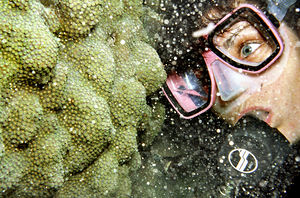TypesofRestoration: Difference between revisions
No edit summary |
|||
| Line 21: | Line 21: | ||
[[File:Coral Spawn.jpg|thumb|300px|Coral spawning event <ref>"Late Summer Full Moons to Cue Spawning on Keys Coral Reefs | NewmanPR." NewmanPR. N.p., n.d. Web. 17 Apr. 2013.</ref>]] | [[File:Coral Spawn.jpg|thumb|300px|Coral spawning event <ref>"Late Summer Full Moons to Cue Spawning on Keys Coral Reefs | NewmanPR." NewmanPR. N.p., n.d. Web. 17 Apr. 2013.</ref>]] | ||
== References == | == References == | ||
<references/> | <references/> | ||
Revision as of 18:33, 31 March 2020
Types of Restoration
Restoration methods attempt to help a degraded and destroyed ecosystem recover their ecological structure and function. There are two types of restoration methods for coral reefs: physical and biological. When implementing restoration methods for coral reefs various types and methods must be used together to succeed.
Physical Restoration
Physical restoration is all about the physical structure of the coral reefs. It is repairing the ecosystem under the lens of an engineer. Physical restoration is used when coral reefs undergo physical stress from activities like bottom trawling, dynamite fishing, and sinking of ships.
When coral reefs undergo physical stress, quick and efficient Triage and Repair methods help alleviate potential after-effect damage and encourage a faster recovery time for coral reefs. For example, physical stress often creates an unstable weak base that overturns and smothers any corals that grow on them. They are the “killing field of coral reefs.” To stabilize the base a stable substrate like flexible rubber cement mats or limestone boulders are placed on top of rubbles to create a stable base for corals to grow on. Another example is the removal of foreign debris that can act as propellants, destroying and wreaking havoc on coral reefs during storms.
Artificial reefs are also created to help maintain needed topographic complexity for a thriving ecosystem. They attempt to mimic the structure and function of reefs. Reef balls and 3-D printed reefs made of marine friendly materials are becoming popular. They provide habitats for corals and other invertebrates, provide shoreline protection, and help alleviate human stress like bottom trawling or tourists.
Major physical restoration can get very expensive costing up from $100,000 to $1,000,000 per hectare. However, if a site needs physical restoration it must be done before biological restoration. For example, biologically restoring corals on unstable bases filled with debris will simply lead to their demise. However, if they are restored on stable bases or on artificial reefs with little foreign debris physical threats are alleviated.
Physical restoration can be effective if they are well planned and done efficiently. After the sinking of the Fortuna Reefer ship in Mona Island, Puerto Rico, defragmented corals were attached to stable substrates with wires, saving 57% of the fragments. However, in Fort Lauderdale, Florida an attempt to create an artificial reef out of tires wired together backfired as the wires came loose under the pressure of storms. These tires rampaged around the reefs destroying corals and the reef.
Biological Restoration
big chunk - Transplantation of babi corals [1]
